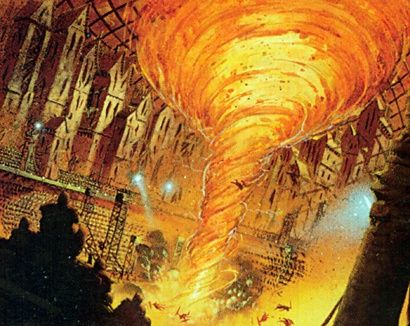
Art by Greg Staples
I’ve been playing Magic: the Gathering off and on since I was introduced to it in high school almost 20 years ago. Quite a few things have changed in the game since then, but nothing in the game has changed so dramatically that the old cards are strictly unplayable. In fact, there are some formats of Magic where incorporating older cards is encouraged. And rather than restrict myself to Standard and Limited for sanctioned play, I’ve decided to branch out into those formats.
This decision is based mostly on the potential for building new and interesting decks. With the entire length and breadth of Magic to choose from, the possibilities are astounding. I mean, sure, not every deck is going to be viable – there’s only so much one can do with, say, Lifelaces and banding creatures – but the potential is there. Unfortunately, to make the most of the format, some investments will have to be made, as many older cards are rather pricey. Dual lands, staples of the games early editions, are often priced at a hundred dollars or more per card.
Thankfully, not every deck requires these powerful cards. Sometimes, when you find yourself on a budget, the simplest ideas are the best.
[mtg_deck title=”Legacy Monored Burn”]
// Creatures
4 Goblin Guide
4 Keldon Marauders
2 Grim Lavamancer
// Spells
4 Lightning Bolt
4 Rift Bolt
4 Fireblast
4 Lava Spike
4 Magma Jet
4 Price of Progress
4 Chain Lightning
2 Sulfuric Vortex
// Lands
3 Arid Mesa
3 Scalding Tarn
14 Mountain
// Sideboard
3 Smash to Smithereens
2 Vexing Shusher
2 Pyrostatic Pillar
2 Pyroblast
2 Anarchy
2 Tormod’s Crypt
1 Ravenous Trap
1 Faerie Macabre
[/mtg_deck]
The deck is fairly straightforward: dishing out as much damage as possible in a short amount of time. However, ‘straightforward’ does not mean ‘simple’. You can’t simply cast all the spells in your hand as quickly as possible and be assured of a win. A key example of this is [mtg_card]Fireblast[/mtg_card]. Canny players wait until after other spells have been cast to play this powerful blow to the enemy’s face with its sacrifice cost. And doing so puts more cards in the graveyard for [mtg_card]Grim Lavamancer[/mtg_card] to use.
I’ve played the deck in one event so far, and it’s not only fun to play but viable against other Legacy decks. Its potential caught me somewhat off-guard, considering I was up against decks like Countertop and Affinity. It’s not perfect, though, as Maverick found ways to slow me down enough to secure a win. Hence the [mtg_card]Anarchy[/mtg_card] in the sideboard – that will take care of pesky Circles of Protection!
In addition to Legacy, the format called Modern provides similar opportunities but with a narrower range of cards to choose from. I had to poke around a bit, but I found a deck list that feels right up my alley, and utilizes some of my favorite cards from both the current and the previous Standard rotation.
[mtg_deck title=”Modern Tokens”]
// Creatures
4 Hero of Bladehold
4 Tidehollow Sculler
// Spells
4 Intangible Virtue
4 Lingering Souls
4 Honor of the Pure
4 Path to Exile
4 Inquisition of Kozilek
3 Zealous Persecution
3 Spectral Procession
3 Midnight Haunting
// Land
4 Godless Shrine
4 Isolated Chapel
4 Marsh Flats
1 Mutavault
6 Plains
1 Swamp
3 Windbrisk Heights
// Sideboard
2 Disenchant
2 Kataki, War’s Wage
2 Kor Firewalker
2 Linvala, Keeper of Silence
2 Slaughter Pact
1 Stony Silence
2 Surgical Extraction
2 Torpor Orb
[/mtg_deck]
Which am I more excited to play? Token decks are always fun to play, but the straightforwardness of the burn deck is also appealing. The deck is somewhat underestimated and isn’t as flashy as decks with dual lands, [mtg_card]Force of Will[/mtg_card], [mtg_card]Tarmogoyf[/mtg_card], or [mtg_card]Jace, the Mind Sculptor[/mtg_card], but it has definitely proved itself and, I feel, will continue to do so.
This doesn’t mean I’m done with more casual formats, though. Especially if there’s drinking involved…



Leave a Reply